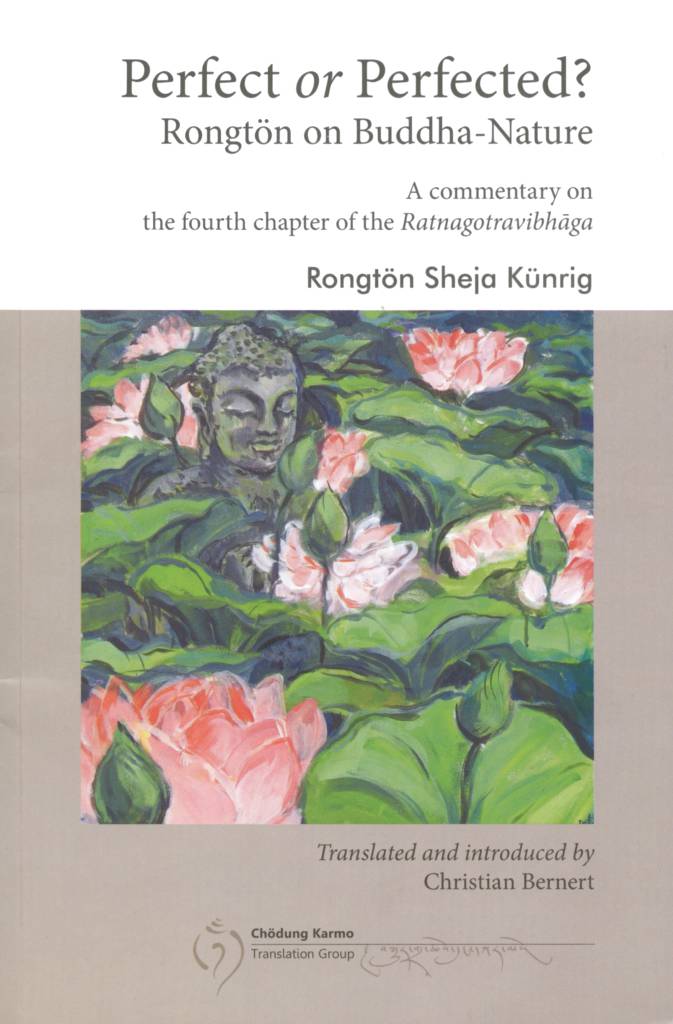... read more at

About this person
Commentary on the Three Reasons
According to Rongtön Shéja Günsi’s commentary on the Uttaratantra,[1] all sentient beings are said to possess the tathāgata heart because the dharmakāya of perfect buddhas radiates, because they possess the suchness that is undifferentiable from the aspect of the natural purity of the suchness of the dharmakāya, and because they have the disposition for the dharmakāya—the capacity of the basic element.
After briefly reporting Ngog Lotsāwa’s above explanation of I.28 and quoting I.27, Rongtön presents the manner in which Uttaratantra I.144–52 and RGVV match the dharmakāya, suchness, and the disposition with the nine examples for buddha nature. He says that the meaning of the tathāgata-dharmakāya’s radiating in all sentient beings is that the dharmakāya of realization pervades all sentient beings, quoting RGVV:
These three examples of a buddha image, honey, and a kernel explain that all sentient beings possess the heart of a tathāgata in the sense of the tathāgata-dharmakāya’s pervading the entire realm of sentient beings without exception.[2]
The citation of Mahāyānasūtrālaṃkāra IX.15 in RGVV is taken as being the reason for this. According to Rongtön, this means that the factor of natural purity—the cause for attaining the fundamental change of both the dharmakāya of realization and the dharmakāya of the teachings—pervades all sentient beings.
Philosophical positions of this person
Sentient beings are endowed with the naturally abiding gotra, but not the dharmakāya.
"Rongtön explains that what is called “the tathāgata heart” is suchness with stains (the basic element not liberated from the cocoon of the afflictions), which is the emptiness of mind with stains. By contrast, the dharmakāya of a tathāgata is what is liberated from this cocoon. The term “tathāgata heart” is used in terms of what is primary because this heart (in the sense of emptiness) is explained to exist at the time of the fruition too. This also refutes the assertion that the fully qualified tathāgata heart is solely the buddhahood that is endowed with twofold purity (natural purity and purity of adventitious stains) because it is explained repeatedly that the primary tathāgata heart is suchness with stains. Rongtön’s commentary on the Abhisamayālaṃkāra says that the Mādhyamikas identify the disposition as the dharmadhātu specified by the six inner āyatanas." Brunnhölzl, K., When the Clouds Part, p. 76.
Other names
- ཤཱཀྱ་རྒྱལ་མཚན་ · other names (Tibetan)
- སྨྲ་བའི་སེངྒེ་ · other names (Tibetan)
- ཤེས་བྱ་ཀུན་གཟིགས་ · other names (Tibetan)
- རོང་ཊཱི་ཀ་པ་ · other names (Tibetan)
- ཤེས་རབ་འོད་ཟེར་ · other names (Tibetan)
- shAkya rgyal mtshan · other names (Wylie)
- smra ba'i seng+ge · other names (Wylie)
- shes bya kun gzigs · other names (Wylie)
- rong TI ka pa · other names (Wylie)
- shes rab 'od zer · other names (Wylie)
- Rongtön Shéja Günsi · other names
- Rongton Sheja Kunrig · other names
Affiliations & relations
- Sakya · religious affiliation
- Nalendra Monastery · primary professional affiliation
- Sangpu Neutok · other professional affiliation
- nil · teacher
- nil · student
- Rong ston shes bya kun gzigs 1997, 80–83.
- J70.




